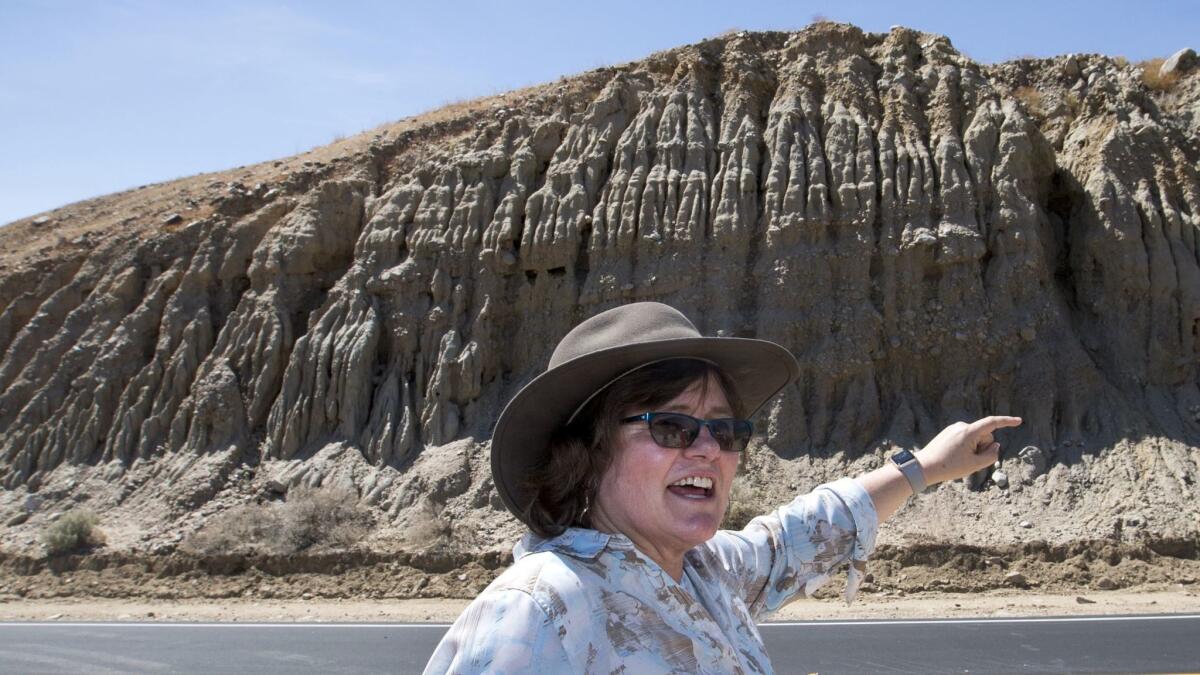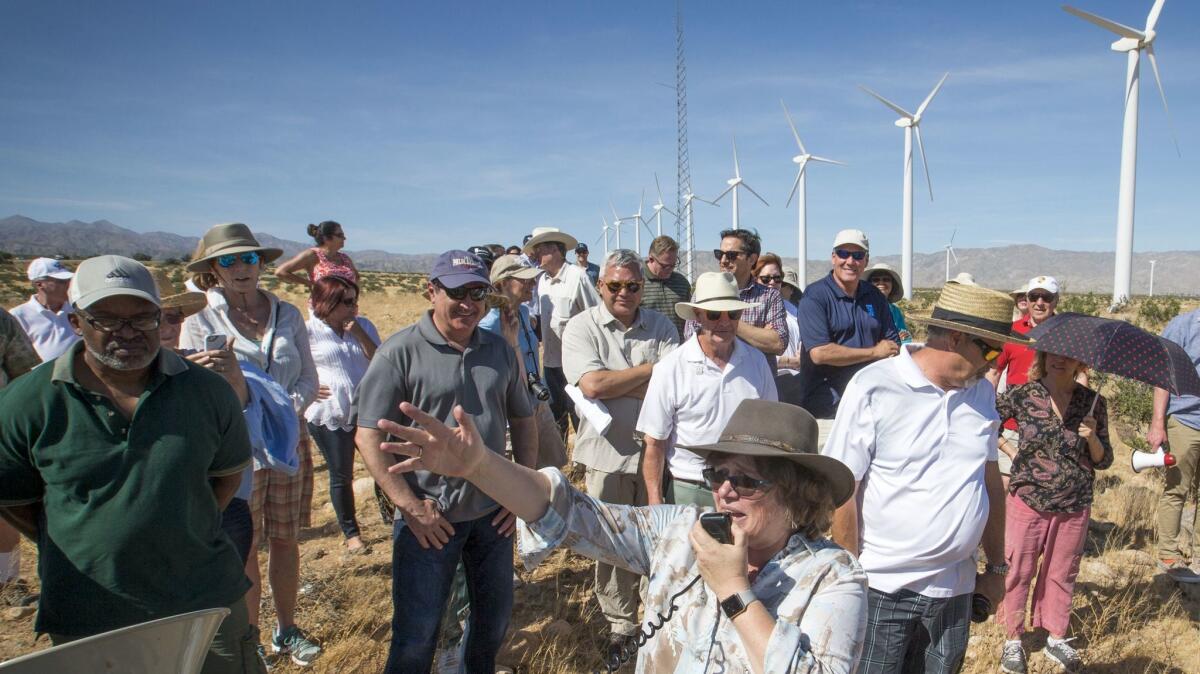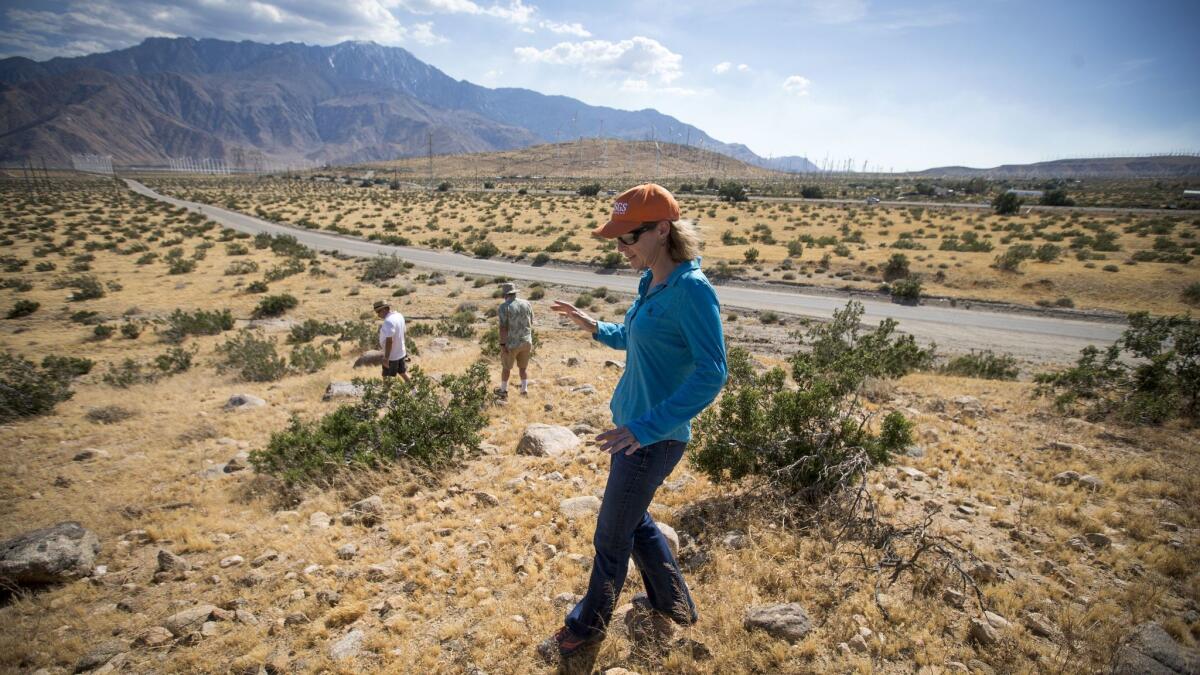Column: Earthquake denial gets a lot harder when you stand on top of the San Andreas fault

- Share via
I had never stood directly on top of the San Andreas fault. Not to my knowledge, anyway, but as a California native, I’ve probably stumbled over it a time or two.
So I jumped at the chance to tour the fault with geophysicist Lucy Jones, the queen of quakes and go-to authority on why the ground keeps shaking.
It’s human nature to live in denial, especially in California, where natural beauty is a sedative. We know the state is cracked and creviced from head to toe, San Francisco once burned to the ground, and we’re overdue for another massive shaker that could take lives, cripple the economy and leave millions of people without water and power for months.
But the mind steers us around horrors we’d rather not contemplate. And then along comes Jones, who isn’t timid about waking people up and scaring the hell out of them.
‘Our building code only asks that buildings not kill you’
We departed from a Palm Desert hotel in two buses packed with city officials who were attending a conference of the Southern California Assn. of Governments. Jones wanted to show them the landscape of lethal forces in the hope they might shore up building codes and take other measures to diminish the potential for catastrophe.
The city of Los Angeles, thanks to Jones’ collaboration with Mayor Eric Garcetti, enacted retrofitting requirements and safety and response standards that are beyond those of most cities in the nation. Santa Monica has done well in that regard, too, in Jones’ opinion, and San Francisco is coming along. (Times reporters helped push this process along with some aggressive reporting on the deadly seismic risks L.A. faces.)
But state building requirements aren’t tough enough, and Jones said local communities need to take up the slack.
“Our building code only asks that buildings not kill you. It does not ask that they be usable” after a quake, said Jones.
That’s bad policy and bad business, too, as Jones sees it. Given the possibility of a 7.8 rupture of the San Andreas, we could have massive destruction of buildings, with multimillion-dollar landlord investments reduced to rubble. We could also see the collapse of transportation routes and disruption of communication, power, water and gas arteries that cross the fault in the Cajon Pass and elsewhere. In other words, the economy could rupture as deeply as the ground.
Our first stop was at a seismic sensor in Indio, very near the fault, and also very near a massive housing development. In a major San Andreas rupture, we’ll see widespread damage in Los Angeles. But the shaking is greater the closer the fault, said Jones. In the 6.5 quake that hit the San Fernando Valley in 1971, houses that straddled the quake were destroyed.
Next, at Thousand Palms, Jones and U.S. Geological Survey geologist Kate Scharer showed us rock formations that tell the story of the time between major quakes. The stretch of the fault from the Salton Sea to Desert Hot Springs has had a major quake every 200 years on average. It’s been 300 years since the last.
And then along comes Jones, who deals in reality, and doesn’t mind scaring the hell out of people.

‘How do you use science to make a community safer?’
The caravan then rolled west along Interstate 10. We exited onto Highway 62, drove up the San Gorgonio Pass and pulled off the road under a crop of windmills.
Scharer led us down a craggy slope to a little ravine she identified as the Banning strand of the San Andreas fault. She had me and my colleague Ron Lin, an earthquake guru, stand next to each other, but on different sides of the fault line.
In a 7.8 earthquake, she said, I’d move in one direction (toward Alaska) and Lin in the other (toward Mexico). Within about 10 seconds, we’d be standing as much as 30 feet apart, if we were still standing. There’d be a gash in the earth, Scharer said, with crevices spidering off the main rupture. It would appear as if the ground had shattered.
Days later, I can’t get that image out of my head.
“How do you use science to make a community safer?” asks Jones, who has retired from the USGS but still serves as visiting associate at the Caltech Seismological Laboratory and runs the Dr. Lucy Jones Center for Science and Society.
It’s a timely question, not just where earthquake potential is concerned, but because the scientific consensus on climate change is under attack.
“Reality is real,” Jones wrote last month for The Times in an op-ed defense of science, “and it doesn’t care what you believe.”
She explained why scientists would be marching en masse on Earth Day, even as the president and national leaders threw doubt on the role humans have played in global warming.
“Science is not a set of facts or even techniques and procedures,” Jones wrote. “Science is a process for understanding the nature of the world.”
Not that she understands everything, but science is more interested in what we don’t know than what we do. I noticed Jones was wearing a crucifix and asked her about it, because faith and science don’t always share the same laboratory.
Her grandfather was a professor of theology, she said, and her father was an aerospace engineer. Lucy grew up an Episcopalian and a believer, developed some doubts as a young adult, then circled back through and beyond the cosmos when she studied the big-bang theory.
“We went from nothing to everything in something less than 10 to the minus-38th seconds. Let there be light,” said Jones. “If creation really happened, I find it a working hypothesis that there’s a creator.”

‘What is the moral duty of a scientist?’
Faith and science are not incompatible, said Jones, and neither are science and art. She studied Chinese language and literature in college and plays the the viola da gamba in an orchestra, and in a state full of originals, Jones could be president of the club, except that she’s too busy explaining what’s happening beneath our feet every time the ground moves.
“What is the moral duty of a scientist?” Jones asked on the bus.
For many, it’s to do essential research. For Jones, it’s to translate the findings in practical terms. If a car is bearing down on a pedestrian, she said, you don’t yell, hey, “Force equals mass times acceleration.” You give them something they can use, like hey, get out of the way.
The plates along the San Andreas are moving at a seismically swift rate of roughly an inch or so a year, building up underground pressure that is guaranteed to produce an epic rupture.
It could happen in a hundred years or it could happen before you finish this paragraph, and Jones is yelling at us to get our building codes and utility lines in order, make our homes as safe as possible and have earthquake kits and water supplies ready.
Science tells it’s not a matter of if, but when.
Get more of Steve Lopez’s work and follow him on Twitter @LATstevelopez
ALSO
In Venice, where money meets misery, hoping for an end to homeless camps
America’s top universities wanted him. How this L.A. teen of modest means earned a wealth of options
LAX’s new private terminal for the rich and famous makes flying easier, but at a steep price
More to Read
Sign up for Essential California
The most important California stories and recommendations in your inbox every morning.
You may occasionally receive promotional content from the Los Angeles Times.











